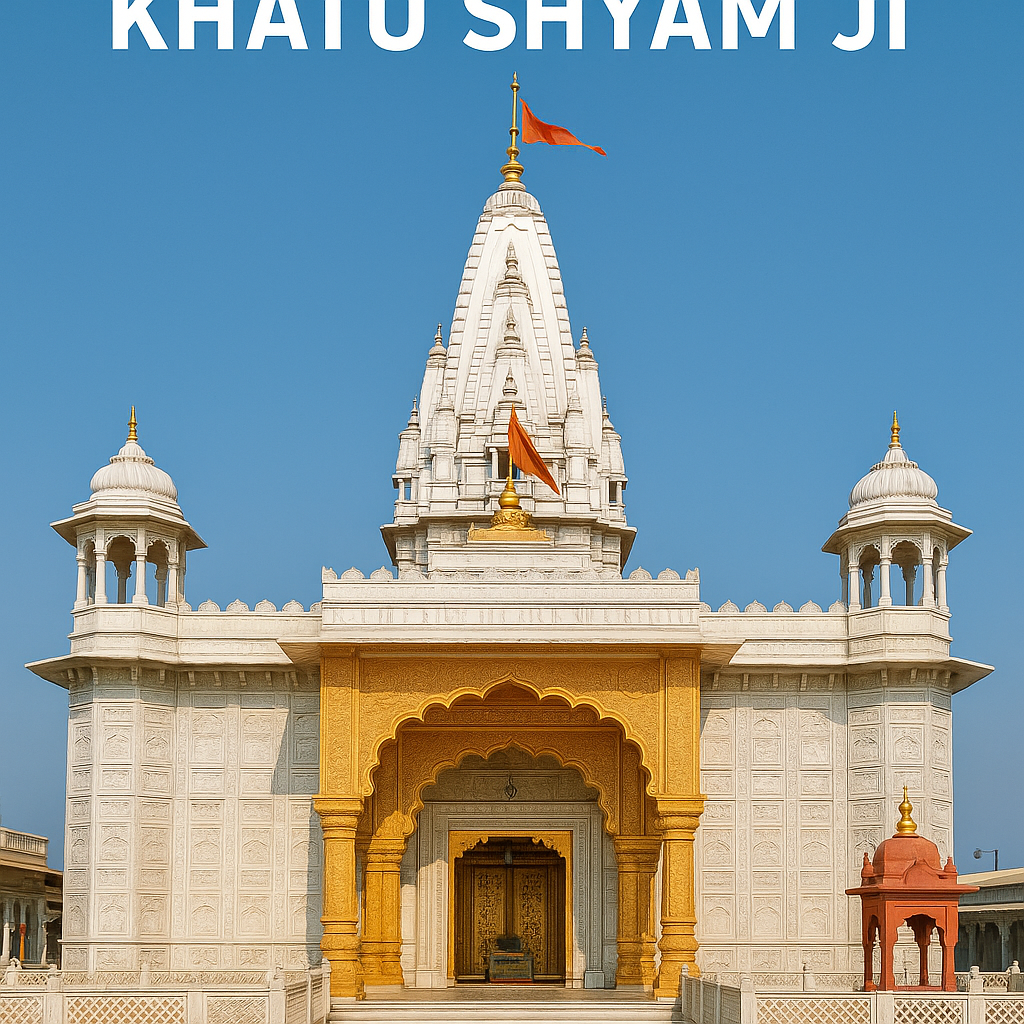India is a land of legends and divinity, and among its many sacred shrines, Khatu Shyam Ji Temple stands as a symbol of immense faith and miraculous devotion. Located in the Sikar district of Rajasthan, this temple is dedicated to Barbarika, the grandson of Bhima, who was blessed by Lord Krishna to be worshipped as Shyam (another name for Krishna) in the age of Kalyug.
Every year, millions of devotees from all corners of the country visit the temple, offering prayers and seeking blessings for courage, prosperity, and peace of mind. Whether you are a pilgrim, a spiritual seeker, or a traveler, Khatu Shyam Ji Temple is a divine destination that offers both spiritual peace and a glimpse into India’s rich mythological heritage.
Table of Contents
Location and Accessibility
Temple Location: Khatu Village, Sikar District, Rajasthan
Nearest Railway Station: Ringas Junction (~18 km)
Nearest Airport: Jaipur International Airport (~90 km)
Best Time to Visit: February–March (during Phalgun Mela), Kartik Purnima, or every Ekadashi
The Legend of Khatu Shyam Ji
Khatu Shyam Ji is believed to be the reincarnation of Barbarika, the powerful warrior who possessed the ability to end the Mahabharata war within moments. Barbarika had vowed to support the weaker side in any battle. Before the war began, Lord Krishna, knowing the devastating potential of Barbarika’s power, disguised himself and asked him about his intentions. When Barbarika explained his vow, Krishna requested his head as a sacrifice to preserve Dharma.
Barbarika agreed without hesitation. In return, Krishna blessed him saying, “In Kalyug, you will be worshipped as my own form—Shyam—and grant boons to those who remember you with true devotion.”
Thus, Khatu Shyam is considered the ‘God of Kalyug’, the one who helps devotees overcome problems in today’s difficult times.
Importance in Kalyug
Unlike traditional deities who are often worshipped for specific qualities, Khatu Shyam Ji is considered an all-powerful deity who blesses those who approach him with a clean heart. Devotees believe:
He listens instantly to genuine prayers
He grants protection from evil forces and bad luck
He removes obstacles from personal and professional life
He is particularly kind to the poor and struggling
Devotees often chant “Shyam Baba Ki Jai!” and offer a coconut tied in a red cloth as a symbolic prayer.
Architecture and Temple Structure
The present-day temple was built in 1027 AD by Roop Singh Chauhan, and it has been renovated and expanded over the centuries.
Key features include:
Marble walls and silver doors
Gold-plated sanctum (garbh griha)
Large prayer hall (Jagmohan) for bhajans and kirtans
A sacred pond named Shyam Kund, where the idol was first discovered
The temple is not just a religious place but a cultural landmark, echoing centuries of devotion.
Major Festivals and Events
1. Phalgun Mela (February–March)
The largest gathering at Khatu Shyam Ji, this festival celebrates the birth of Shyam Baba with:
Massive processions
All-night bhajans and kirtans
Langars (free food distribution)
Foot pilgrimages from nearby towns
2. Ekadashi & Dwadashi
These monthly lunar days are considered auspicious for Shyam Baba’s worship. Devotees observe fasts, offer sweets and flowers, and chant Shyam Chalisa.
3. Janmashtami & Gopashtami
Though related to Lord Krishna, these are also celebrated with great devotion as Shyam Baba is his manifestation.
Rituals and Offerings
Devotees offer nariyal (coconuts), gulal, sweets, and chunni (scarves)
Most people tie a red thread or cloth near the deity for wish fulfillment
Shyam Bhajan Mandalis (singing groups) hold devotional nights across India
It is believed that once your wish is granted, you must return to the temple and offer prasadi (thanksgiving prayer).
Spiritual Experience at Khatu
Whether it’s the sound of bhajans, the aroma of incense, or the sight of thousands bowing in unison, Khatu Shyam Ji evokes a divine energy that is hard to describe. Many claim to experience:
Peace of mind
Sudden resolution of problems
Emotional healing
Clarity in personal or career decisions
Shyam Baba is often called “Khatu Naresh” (King of Khatu) for his divine power and kindness.
Facilities for Pilgrims
Numerous dharamshalas (guesthouses) available near the temple
Affordable hotels and lodges with basic amenities
Free food distribution (langar) during peak festivals
Local vendors sell Shyam Baba flags, photos, malas, and prasad
It’s advisable to book accommodation in advance during Phalgun Mela and major holidays.
Khatu Shyam in Today’s World
Even in today’s modern and fast-paced life, Khatu Shyam Ji continues to draw young and old alike. His increasing presence in digital bhajan apps, YouTube live aartis, and social media groups reflects the timeless appeal of faith and surrender.
His teachings are simple:
“Have faith, don’t lose hope, and surrender your worries at my feet.”
Conclusion
Khatu Shyam Ji is more than just a temple or deity—he represents unconditional love, hope, and divine justice in the age of chaos. Every chant of “Hare Ka Sahara, Khatu Shyam Hamara” echoes the belief that when all doors are closed, Shyam Baba opens a new one.
So, whether you’re seeking a miracle, peace, or simply a deeper connection with the divine, Khatu Shyam Ji’s temple awaits with open arms.











